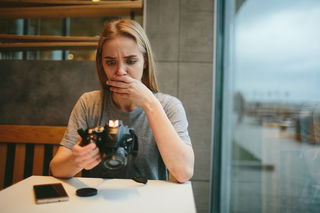Bias
2 Key Reasons We May Dislike Photos of Ourselves
We tend to dislike our photographs, but there are ways to like them more.
Posted October 10, 2017 Reviewed by Ekua Hagan

Have you ever seen a perfect photograph of yourself, one that really reflects your perception of how you look? Or does each photograph seem to come up short in some way? There are scientific reasons why we tend to dislike photographs of ourselves, but there are also strategies we can use to increase our fondness for our own photographs.
Reasons We Dislike Our Own Photographs
1. We think we're more attractive than we actually are. When we think about ourselves, we are prone to a bias called self-enhancement, which is the tendency to evaluate our “own traits and abilities more favorably than is objectively warranted” (Epley and Whitchurch, 2008 p. 1159). In the case of physical appearance, this bias leads us to believe that we are more attractive than we actually are.
Evidence for this bias is revealed when researchers ask individuals to identify photographs of themselves. For example, researchers have presented participants with real photographs of themselves, as well as photographs that have been manipulated to be more or less attractive (through morphing participants’ own photographs with photographs of attractive and unattractive others). They then asked participants to choose the real photograph of themselves. Participants consistently chose photographs that had been manipulated to be more attractive as their “real” photographs, whereas strangers accurately chose the real photographs of those same individuals (Epley and Whitchurch, 2008). Our dissatisfaction with our actual photographs may reflect this self-enhancement bias: When we perceive ourselves as more attractive than we really are, the reality of our true appearance can disappoint.
2. The mere exposure effect works against us. The mere exposure effect suggests that the more we encounter a stimulus, the more we tend to like it (Zajonc, 1968). It stands to reason that if we see ourselves often—for example, in the mirror—so we should find ourselves more attractive. However, when we look at ourselves in the mirror, our image is reversed, while in photographs of ourselves it is usually not. One reason that we don’t particularly like photographs of ourselves is that those pictures present a view of our faces which is less familiar to us. In fact, researchers have shown that individuals prefer photographs showing their mirror images, while others tend to prefer photographs of those same individuals which show their “true” images (Mita et al., 1977).
How to Like Your Photographs More
1. Use the mere exposure effect to your advantage. Because we know that repeated exposure to a stimulus facilitates liking, we can use the mere exposure effect to increase our liking for our own photographs. However, research shows that exposures of shorter durations are more effective at increasing liking than longer duration exposures (Bornstein, 1989). Using a photograph as a background photo on your cell phone, or rapidly scanning through photographs of yourself, may provide repeated short exposures and may increase liking for those photographs. Alternatively, you may consider using a photo app that allows you to take a mirror-image photograph.
2. Take a selfie. Do you prefer selfies to traditional photographs of yourself? Many individuals do, especially if they take selfies regularly (Re et al., 2016). However, you should be aware that selfies only make you seem more attractive to yourself. When evaluating photographs of other people, most of us prefer photographs taken by someone else over selfies (Re et al., 2016).
3. Smile. Observing a smile enhances activation in the medial orbitofrontal cortex area of the brain, an area associated with reward (O'Doherty et al., 2003). Smiling also increases our perceptions of attractiveness. In fact, in research assessing the attractiveness of faces, Golle and colleagues (2014) found that happier faces were consistently rated more attractive, even when those faces were manipulated to look less attractive. Smiling faces were judged as more attractive than faces that were better looking, but less happy.
4. Cultivate happiness. My favorite photos of myself are those in which I am the happiest, and research reveals a connection between happiness and attractiveness (Deiner et al., 1995; Gupta et al., 2016). Although most researchers interpret these results as suggesting that attractive people are happier, because this research is correlational, it may also be the case that happier people are more attractive. The research on smiling reviewed above supports this interpretation.
5. Look at old photos. This last bit of advice is not scientific, but I have found it to be effective in my personal experience. As I lamented a particularly unflattering photo of myself, my mother-in-law observed that when she looks back on old photos, she always likes the way she looks. Try looking through your old photographs. (My mother-in-law suggests looking back 10 years.) You won't believe how young and stunning you look.
Portions of this post were taken from The Social Psychology of Attraction and Romantic Relationships. Copyright 2015 Madeleine A. Fugère.
Facebook image: Estrada Anton/Shuterstock
References
Bornstein, R. (1989). Exposure and affect: Overview and meta-analysis of research, 1968–1987. Psychological Bulletin, 106(2), 265–289. doi:10.1037/0033-2909.106.2.265
Diener, E., Wolsic, B., & Fujita, F. (1995). Physical attractiveness and subjective well-being. Journal of Personality and Social Psychology, 69(1), 120.
Epley, N., & Whitchurch, E. (2008). Mirror, mirror on the wall: Enhancement in self-recognition. Personality and Social Psychology Bulletin, 34(9), 1159-1170.
Golle, J., Mast, F. W., & Lobmaier, J. S. (2014). Something to smile about: The interrelationship between attractiveness and emotional expression. Cognition & Emotion, 28(2), 298-310.
Gupta, N. D., Etcoff, N. L., & Jaeger, M. M. (2016). Beauty in mind: The effects of physical attractiveness on psychological well-being and distress. Journal of Happiness Studies, 17(3), 1313-1325.
Mita, T. H., Dermer, M., & Knight, J. (1977). Reversed facial images and the mere-exposure hypothesis. Journal of Personality and Social Psychology, 35(8), 597.
O’Doherty, J., Winston, J., Critchley, H., Perrett, D., Burt, D. M., & Dolan, R. J. (2003). Beauty in a smile: the role of medial orbitofrontal cortex in facial attractiveness. Neuropsychologia, 41(2), 147-155.
Zajonc, R. (1968). Attitudinal effects of mere exposure. Journal of Personality and Social Psychology, 9(2, Pt.2), 1–27. doi:10.1037/h0025848.
Re, D. E., Wang, S. A., He, J. C., & Rule, N. O. (2016). Selfie indulgence: Self-favoring biases in perceptions of selfies. Social Psychological and Personality Science, 7(6), 588-596. doi:10.1177/1948550616644299




